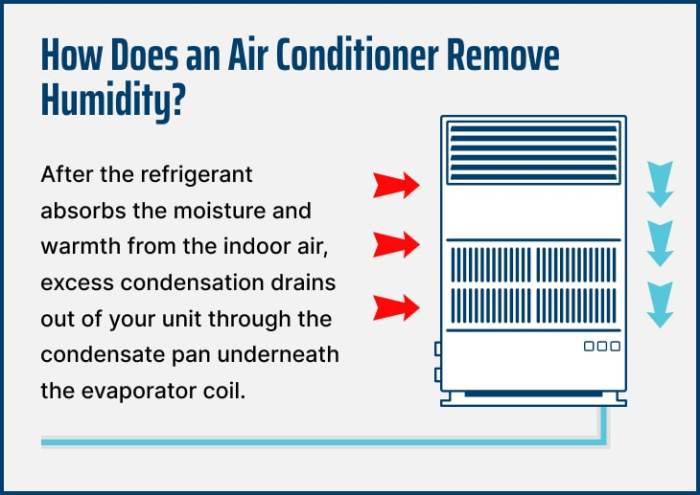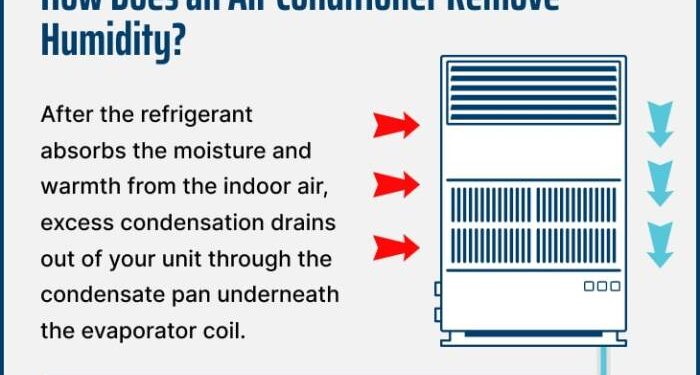Embark on a journey to discover the secrets of reducing humidity with an air conditioner. Uncover the impact of humidity on indoor comfort and how air conditioners play a crucial role in maintaining optimal levels.
Delve deeper into the dehumidification process, learn about essential components, and understand the significance of temperature control.
Introduction to reducing humidity with an air conditioner

Humidity refers to the amount of moisture present in the air. High humidity levels can make indoor spaces feel uncomfortable and sticky, leading to issues like mold growth and musty odors.
An air conditioner plays a vital role in reducing humidity by cooling the air and removing excess moisture through condensation. This process helps maintain optimal humidity levels, typically between 30-50%, for a more comfortable and healthier indoor environment.
Benefits of maintaining optimal humidity levels
- Prevents mold growth: Excess moisture can create a favorable environment for mold to thrive. By reducing humidity levels, an air conditioner helps prevent mold growth, which can be harmful to health.
- Improves indoor air quality: Lower humidity levels can reduce the presence of allergens like dust mites and mold spores in the air, leading to better indoor air quality and overall respiratory health.
- Enhances comfort: High humidity levels can make spaces feel warmer than they actually are, causing discomfort. By reducing humidity, an air conditioner can help create a more comfortable living or working environment.
- Protects belongings: Excessive moisture in the air can damage furniture, electronics, and other belongings. Maintaining optimal humidity levels with an air conditioner can help protect these items from potential harm.
Understanding how air conditioners reduce humidity
When it comes to reducing humidity, air conditioners play a crucial role in creating a more comfortable indoor environment. Let's delve into how air conditioners achieve this by dehumidifying the air.
Dehumidification Process in Air Conditioners
Air conditioners reduce humidity through a process called dehumidification. As warm air from the room is drawn into the air conditioner, it passes over the evaporator coils. These coils are cooled down, causing the moisture in the air to condense into water droplets.
The water is then collected and drained out of the unit, effectively removing humidity from the air.
Components Responsible for Humidity Control
- The Evaporator Coils: These coils cool the air and cause condensation of moisture, reducing humidity levels.
- The Condensate Drain: This component collects the water that forms during the dehumidification process and removes it from the unit.
- The Thermostat: By setting the desired temperature on the thermostat, you can control how often the air conditioner runs to dehumidify the air.
Effect of Lowering Temperature on Humidity Levels
Lowering the temperature in a room using an air conditioner also helps reduce humidity levels. Cold air holds less moisture than warm air, so as the air cools down, the relative humidity decreases. This is why running an air conditioner not only cools the air but also dehumidifies it, making the indoor environment more comfortable.
Setting up the air conditioner for humidity control
When it comes to reducing humidity with an air conditioner, setting it up correctly is crucial for optimal performance. Here are some tips to help you get the most out of your air conditioner for dehumidification
Selecting the right air conditioner for dehumidification
- Look for an air conditioner with a built-in dehumidifier function specifically designed to remove excess moisture from the air.
- Consider the size of the room you want to dehumidify to ensure the air conditioner has the capacity to handle the humidity levels effectively.
- Choose an energy-efficient model to save on electricity costs while effectively reducing humidity.
Ideal temperature and fan settings for reducing humidity
- Set the air conditioner temperature to around 78°F (25°C) for optimal dehumidification without overcooling the room.
- Use the "auto" fan setting to allow the air conditioner to adjust the fan speed based on the humidity level in the room.
- Avoid setting the temperature too low, as this can lead to increased energy consumption without significantly reducing humidity levels.
Importance of regular maintenance for optimal dehumidification
- Keep the air filters clean and replace them regularly to ensure efficient airflow and proper dehumidification.
- Check for any leaks or blockages in the air conditioner unit that may affect its ability to remove moisture from the air.
- Schedule annual maintenance checks with a professional to ensure that your air conditioner is functioning properly and efficiently.
Additional methods to reduce humidity in conjunction with an air conditioner
Reducing humidity in your home can be achieved more effectively by combining the use of an air conditioner with other methods. Here are some additional strategies to consider:
Using a dehumidifier alongside the air conditioner
One effective way to further reduce humidity in your home is to use a dehumidifier in conjunction with your air conditioner. While the air conditioner helps cool the air and remove some moisture, a dehumidifier specifically targets excess humidity, making the air even more comfortable.
Improving ventilation to aid in humidity reduction
Proper ventilation is crucial in reducing humidity levels in your home. Make sure to open windows and doors when weather permits to allow fresh air to circulate and carry moisture out. Using exhaust fans in kitchens and bathrooms can also help remove humid air from these areas.
Utilizing exhaust fans or moisture-absorbing materials
In addition to using a dehumidifier and improving ventilation, other strategies can also be helpful. Installing exhaust fans in high-humidity areas like the kitchen and bathroom can help remove moisture. Placing moisture-absorbing materials such as silica gel or activated charcoal in closets or other enclosed spaces can also aid in reducing humidity levels.
Final Review
In conclusion, mastering the art of reducing humidity with an air conditioner can transform your living space. By following the tips and strategies discussed, you can create a more comfortable environment for yourself and your loved ones.
FAQs
How often should I change the air filters in my air conditioner?
It's recommended to change air filters every 1-3 months to ensure optimal performance and humidity control.
Can an air conditioner work as a substitute for a dehumidifier?
While air conditioners can help reduce humidity, they are not as effective as dehumidifiers in extremely humid conditions.
Is it necessary to hire a professional for air conditioner maintenance?
Regular maintenance by a professional can prolong the lifespan of your air conditioner and ensure efficient dehumidification.



